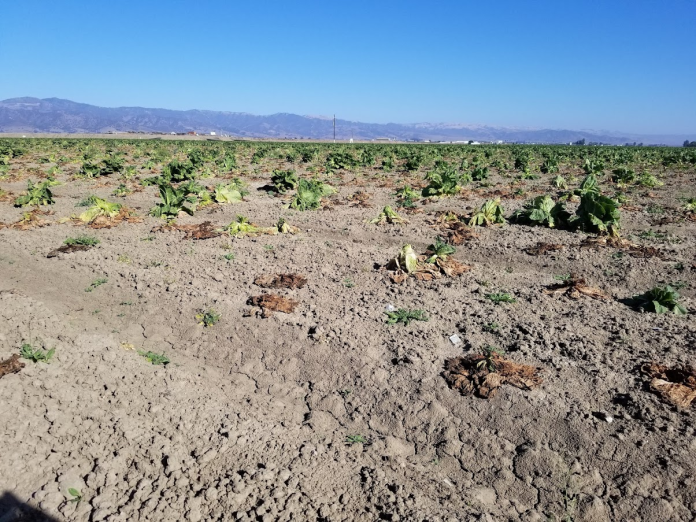
Controlling host weeds and the disease vector are primary concerns for Salinas Valley lettuce growers as the reemergence of western flower thrips-vectored Impatiens Necrotic Spot Virus (INSV) has caused significant yield losses.
Mary Zischke, who leads an INSV task force created by Grower-Shipper Association of Central California, said the winter offseason for lettuce is a critical time to control host weeds.
INSV in lettuce causes necrotic patterns on the inner leaves of the plant as well as significant stunting. Zischke’s task force is identifying major research questions, examining treatment strategies and developing treatment efficacy levels. The task force is also building a grower education program specific to viral disease and is establishing a network for information sharing.
Lettuce is a key host for INSV during the lettuce production season, but during the winter when there are no lettuce fields, the virus survives in weedy host plants in a variety of habitats: roadsides, ditches, waste areas around equipment yards, and natural areas. Vineyards can also be habitat for INSV due to the presence of infected weed hosts.
Task force GAPS that are being recommended to growers and farm managers include disking harvested fields as soon as possible and aggressively managing weed hosts. That includes weeds in lettuce fields, other adjacent crops and border areas where possible.
Preferred weed hosts include hairy fleabane, annual sow thistle, common lambsquarter, purslane, field bindweed, malva, mare’s tail and nettleleaf goosefoot.
Little mallow, annual sow thistle and nettleleaf goosefoot are also common in vineyards and have relatively high levels of INSV, being good hosts for thrips, particularly when flowering.
Weed control is particularly important in the spring when thrips populations begin to increase. It is unclear how far thrips can move, but they rely heavily on the Salinas Valley winds for long-distance dispersal. Monitoring efforts showed that thrips are equally distributed in the wind column up to 10 feet high and have even been detected in moderate numbers at heights above 20 feet.
Zischke said a USDA Salinas monitoring program is in place to report thrips activity on a year-round basis.
Losses from INSV in 2020 exceeded $50 million. The INSV Task Force, composed of growers, PCA’s, the Grower-Shipper Association, the County Agricultural Commissioner and researchers, meets weekly to discuss ways of reducing the spread of INSV.




















